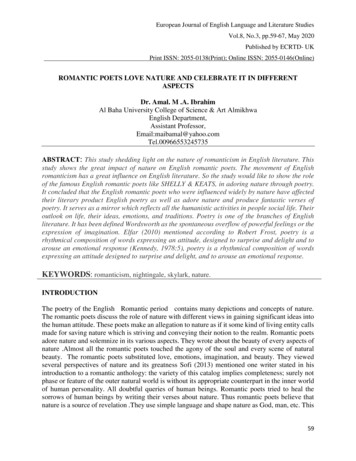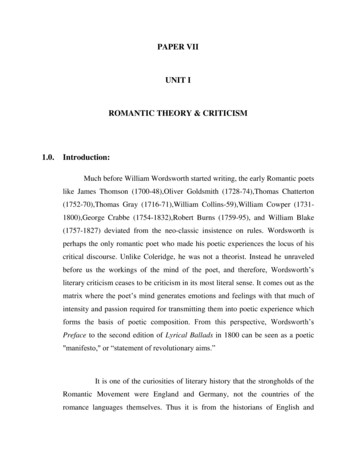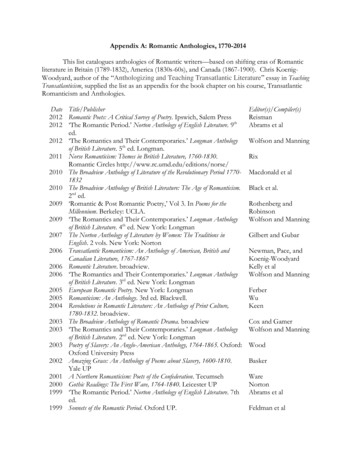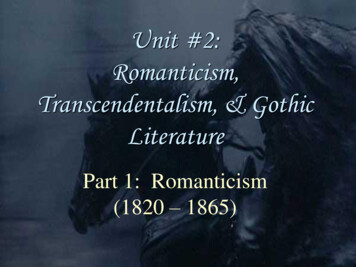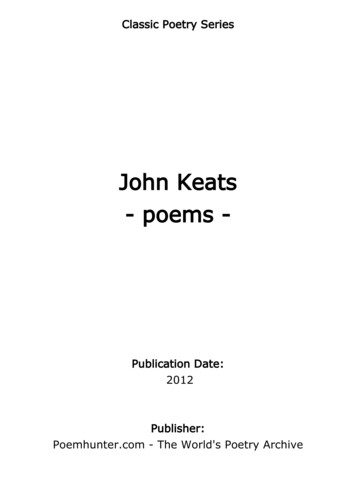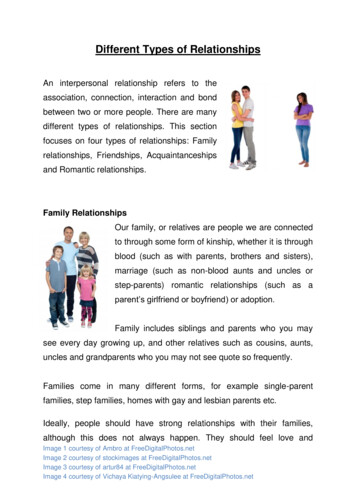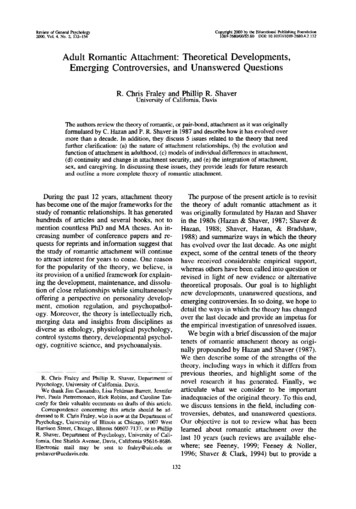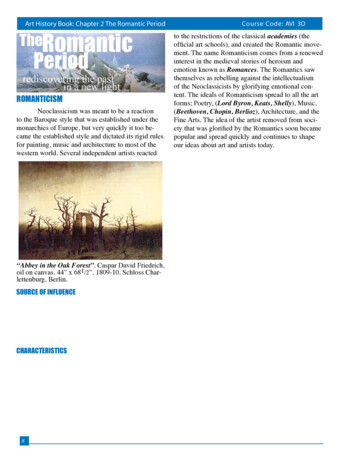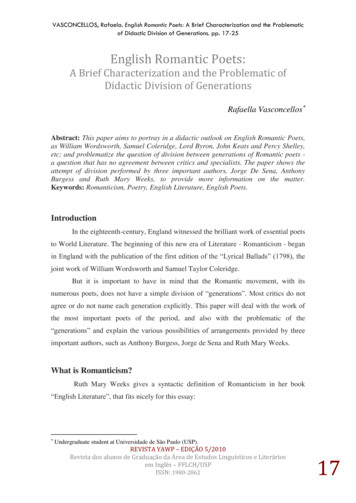
Transcription
VASCONCELLOS, Rafaela. English Romantic Poets: A Brief Characterization and the Problematicof Didactic Division of Generations. pp. 17-25English Romantic Poets:A Brief Characterization and the Problematic ofDidactic Division of GenerationsRafaella Vasconcellos Abstract: This paper aims to portray in a didactic outlook on English Romantic Poets,as William Wordsworth, Samuel Coleridge, Lord Byron, John Keats and Percy Shelley,etc; and problematize the question of division between generations of Romantic poets a question that has no agreement between critics and specialists. The paper shows theattempt of division performed by three important authors, Jorge De Sena, AnthonyBurgess and Ruth Mary Weeks, to provide more information on the matter.Keywords: Romanticism, Poetry, English Literature, English Poets.IntroductionIn the eighteenth-century, England witnessed the brilliant work of essential poetsto World Literature. The beginning of this new era of Literature - Romanticism - beganin England with the publication of the first edition of the “Lyrical Ballads” (1798), thejoint work of William Wordsworth and Samuel Taylor Coleridge.But it is important to have in mind that the Romantic movement, with itsnumerous poets, does not have a simple division of “generations”. Most critics do notagree or do not name each generation explicitly. This paper will deal with the work ofthe most important poets of the period, and also with the problematic of the“generations” and explain the various possibilities of arrangements provided by threeimportant authors, such as Anthony Burgess, Jorge de Sena and Ruth Mary Weeks.What is Romanticism?Ruth Mary Weeks gives a syntactic definition of Romanticism in her book“English Literature”, that fits nicely for this essay: Undergraduate student at Universidade de São Paulo (USP).REVISTA YAWP – EDIÇÃO 5/2010Revista dos alunos de Graduação da Área de Estudos Linguísticos e Literáriosem Inglês – FFLCH/USPISSN: 1980-286217
VASCONCELLOS, Rafaela. English Romantic Poets: A Brief Characterization and the Problematicof Didactic Division of Generations. pp. 17-25The impulse thus to abandon old ways of thinking and living, the insistence onindividual freedom, and the glowing confidence with which the English poets ofthis period regarded the future make up an attitude of mind called romanticism.(p. 581).Furthermore,[ ] the romanticist is [ ] not dominated by common sense; he is willing totake a chance. He values emotion and enthusiasm more highly than cold logic.He strives not for social correctness but for individuality and independence [ ](p. 581).These characteristics will show themselves in the lives and works of allRomantic poets exposed in this essay.The Romantic PoetsFormally, the birth of English Romanticism, as already mentioned, was in 1798,in which the “Lyrical Ballads” was published. It contained individual poems ofWordsworth and Coleridge, after an unsuccessful attempt of creating poetry together. Inits preface, Wordsworth establishes, in a text that could be called a “manifest” or even a“critical essay”, the principles of how the composition of poetry should be done: Thelanguage should be the one used by common people, “conserved stainless in thespeaking of country people”1; it should not be rationalized, should contain imagination,legend, human heart2; Jorge de Sena even mentions the poetical revolution that workintended to propose3. But both authors of such extraordinary work, Wordsworth andColeridge, did not agree in its principles: many of them were criticized by Coleridge,more realist than his partner.Wordsworth lived a long life, unlike other Romantic poets. He went toCambridge and also to post-revolutionary France, in 1790, where he wrote: “Bliss was1BURGESS, Anthony. “A Literatura Inglesa”. São Paulo: Editora Ática, p. 197.Ibidem, p. 197.3DE SENA, Jorge. “A Literatura Inglesa: Ensaio de Interpretação e História”. São Paulo: Cultrix, 1963,p. 237.2REVISTA YAWP – EDIÇÃO 5/2010Revista dos alunos de Graduação da Área de Estudos Linguísticos e Literáriosem Inglês – FFLCH/USPISSN: 1980-286218
VASCONCELLOS, Rafaela. English Romantic Poets: A Brief Characterization and the Problematicof Didactic Division of Generations. pp. 17-25it in that dawn to be alive, / But to be young was very Heaven!”4. Wordsworth wascredited as being very excited about the French Revolution and its consequences; but in1793, the war between England and France started, and he was obligated to return to hishomeland. His enthusiasm towards youth, democracy and revolution died, andWordsworth became a very conservative poet, being even consecrated as poet Laureatewhen older.He was one of the first poets that was able to survive on his poetry; in 1795, hereceived some money from a dead friend and met Samuel Taylor Coleridge, whobecame a great friend of his. Although they discovered not having much in common ontheir ideologies, they belonged to one of the most successful literary partnership.Concerning Wordsworth‟s poetical abilities, he believed the poet was a prophet,not the transmitter of the other men‟s truth, but the founder of his own truth; he was apantheist, in which Nature meant more to him than any other systems. Nature was thesource of happiness to men; where men can meet God5. Burgess exemplifies thishegemony of Nature with the excerpt:A presence that disturbs me with the joyOf elevated thoughts; a sense sublimeOf something far more deeply interfused,Whose dwelling is the light of setting suns,And the round ocean and the living air,And the blue sky, and in the mind of man.(Tintern Abbey; lines 94-9)Most importantly, Wordsworth considers people that live “among” nature arepurer and wiser than those ones that live in the city, and even their language is lesscorrupt. His theory of poetic language comes from his deep philosophy of nature6.Further more, Samuel Taylor Coleridge is another important poet thatcontributed to the Romantic movement. His themes concern the magical, the fabulous,the mysterious and the supernatural, pointed by Anthony Burgess as items that4WORDSWORTH, William. Trad.: John Milton. “O Olho Imóvel pela Força da Harmonia”. São Paulo:Ateliê Editorial, 2007, p. 12.5Idem item 1, p. 198.6Idem item 1, p. 199.REVISTA YAWP – EDIÇÃO 5/2010Revista dos alunos de Graduação da Área de Estudos Linguísticos e Literáriosem Inglês – FFLCH/USPISSN: 1980-286219
VASCONCELLOS, Rafaela. English Romantic Poets: A Brief Characterization and the Problematicof Didactic Division of Generations. pp. 17-25Wordsworth and Coleridge never agreed with7: the former fixed his poetry in thepresent and in everyday life, and the latter, in the past and in the wonderful.Coleridge preferred the fantasy, the “suspension of disbelief”, the supernatural;addicted to opium (not illegal at the time), he created poems covered with colors,visions, mysterious happenings, exotic themes, etc. His three most famous poems areThe Rime of the Ancient Mariner, Christabel and Kubla Khan. Unlike his longtimefriend Wordsworth, Coleridge did not focus his poetry on only earthly themes, he usedsupernatural images and fabulous creatures, far from the quietness of nature and itstranquility. Coleridge finished his days - of a long life - dedicated to philosophy andcritique; the greatest critic of English literature, according to De Sena (p. 243).Burgess quoted that if John Keats, who lived a short life, had lived beyond his26 years, he would have become one of the greatest poets of all times8. His poetry isvery sophisticated, lyrical and musical, it shows the sensuality of the Romanticmovement9; his themes are simple, such as the beauty in art and nature; the wish fordeath; happy and unhappy love affairs; the enchant of classical past10; many times, heshows the pleasure of the senses - “wine, love and sounds of nature”11; the suffering;but most frequent themes are beauty and sensuality themselves.Keats did not want to be a public figure as Byron and Shelley; he was aware ofhis complex personality, and against all kinds of “selfmystification”. For him, poetrywas, beyond all things, a piece of art. Jorge De Sena affirms that[ ] foi a publicação das cartas [ ] o que revelou tanta experiência anterior, quantadensidade de pensamento, quanta paixão amadurecida, quanta reflexão sobre a natureza,da poesia iam naquela sensualidade vibrantemente contida, cujas ressonânciasdiscretamente apelavam, afinal mais que os entusiasmos de Byron e de Shelley, para aconsciência profunda. (p. 265)Being a polemic man, Percy Bysshe Shelley honored his fame. He came from anaristocratic family and had financial independence, but he was not very good infollowing the rules: Shelley went to Oxford in 1810 and declared himself atheist,vegetarian, opposite to marriage, an “universal love lawyer” (in the words of Anthony7Idem item 1, p. 200.Idem item 1, p. 204.9Idem item 8.10Idem item 8.11Idem item 1, p. 205.8REVISTA YAWP – EDIÇÃO 5/2010Revista dos alunos de Graduação da Área de Estudos Linguísticos e Literáriosem Inglês – FFLCH/USPISSN: 1980-286220
VASCONCELLOS, Rafaela. English Romantic Poets: A Brief Characterization and the Problematicof Didactic Division of Generations. pp. 17-25Burgess), ensuring his expulsion from the university; he even lived in a mènage a troiswith two women. Shelley is the most political of all Romantic poets.12 All his longerpoems talk about rebellion, revolts, the chained suffering humanity.13 Ruth M. Weekscalls him “a master of rhythm” (p. 647). De Sena makes an essencial assertment aboutShelley:Na larga produção que foi a sua [ ] a poesia atinge uma abstração visionária,em que o libertarismo anárquico, uma conceção livre do erotismo, umasensualidade intelectualizada, o ateísmo espiritualista [.] se conjugam parauma afirmação esplêndida de lirismo, que não é meditação ensimesmada ante aNatureza, como em Wordsworth, nem frustrada e dolorosa angústia daimaginação impotente, como em Coleridge, nem personalismo sarcástico, comoem Byron, nem sensual vivência das coisas e dos seres, como em Keats, masexpressão de um espírito que tudo transfigura - inquietações, angústias, sonhose paixões - naquela beleza intelectual que cantou num hino extraordinário.(p.263)He is known for his poems that talk about nature, but recently his work is beingreinterpreted through readings of a “Red Shelley”: a social, socialist and revolutionaryShelley. As an example, one of his most famous poems, “Ode to the West Wind”, canbe read as renewals in terms of spring and times, and also as social happenings; it is hissaying that “change is coming everywhere”.O wild West Wind, thou breath of Autumn‟s being,Thou, from whose unseen presence the leaves deadAre driven, like ghosts from an enchanter fleeing,Yellow, and black, and pale, and hectic red,Pestilence-stricken multitudes; O thou,Who chariotest to their dark wintry bedThe wingèd seeds, where they lie cold and low,Each like a corpse within its grave, until1213SHELLEY, Percy Bysshe. “Sementes Aladas”. São Paulo: Ateliê Editorial, 2010, p. 12.Idem item 1, p. 203.REVISTA YAWP – EDIÇÃO 5/2010Revista dos alunos de Graduação da Área de Estudos Linguísticos e Literáriosem Inglês – FFLCH/USPISSN: 1980-286221
VASCONCELLOS, Rafaela. English Romantic Poets: A Brief Characterization and the Problematicof Didactic Division of Generations. pp. 17-25Thine azure sister of the Spring shall blow(Ode to the West Wind, lines 1-9)The fifth great English Romantic poet is also a very polemic man, like hisacquaintance and friend, Shelley: George Gordon, or most known as Lord Byron, wasthe personification of the heroes of his poems; an impetuous, proud, athletic andcharming man whose life no one could rule but himself. He had no interest for lifeitself, and lived a life of orgies, smoking and drinking; Byron lived in conflict withsociety and its values at the time, as he felt misunderstood; he was deported fromEngland because of the life he had back then. Anthony Burgess calls him a “pleasantcynical”14; Ruth M. Weeks affirmed that:One powerful conviction dominated all Byron‟s work: the hatred of oppressionand the love of freedom. For this cause, he wrote his greatest poem; and for thiscause he lost his life in the Greek Revolution. In the generous sincerity of theseconvictions and in the grandeur of his verse, we forget the poseur who draggedacross Europe „the pageant of his bleeding heart‟, and remember only his„clainless mind‟15.Byron fought against tyranny for the Greek Independence, and died young, atbattle. His most famous work, the long poem “Don Juan”, shows a man that seducesevery woman that crosses his path without any commitment with feelings; the poem isfull of irony, satire, sensuality, images of the exotic (Spain); it has fluid language, and astrong social critique.Curiously, William Blake is associated with the Romantic movement, butchronologically does not belong to it. His first publication, “Poetical Sketches”, is from1783, and contained many of his most beautiful short poems;16 that is why Jorge deSena includes him in the “category” (if it can be named so) “Pre-Romantic Poets”.Jorge de Sena affirms that Blake was an engraver, painter and poet who hadvisions of supernatural entities that followed him through his life, and believed thatappearance and reality were only one and the same, as what he “saw” and what he14Idem item 1, p. 201.WEEKS, Ruth Mary. “English Literature”. New York: Charles Scribner‟s Sons, p. 62216Idem item 3, p. 225.15REVISTA YAWP – EDIÇÃO 5/2010Revista dos alunos de Graduação da Área de Estudos Linguísticos e Literáriosem Inglês – FFLCH/USPISSN: 1980-286222
VASCONCELLOS, Rafaela. English Romantic Poets: A Brief Characterization and the Problematicof Didactic Division of Generations. pp. 17-25“understood”17. Blake was a mystic “who claimed to talk daily with spirits and angels.[ ] a poet who lived in an inner world of emotion and vision.”18; he created his ownmythology and used it in many of his poems, which he illustrated with his engravings.De Sena also affirms that almost all Romantic professionals were incapable ofunderstanding this genious that lived among them, who was “o Romanticismo empessoa”19, above, out and against all schools.Ruth Mary Weeks calls him “the first note of dissent”20, as a reference to theRomantic movement and its radical changes against the rules of the period. Blake‟spoetry is credited to be one of the most original of all times. Blake saw the roughrealities of his time, but also had the sensibility to see the happy simplicity of a child.The most frequent themes of his work are his anti-Church religion; the suppression ofnatural desires; the body as an extension of the soul, etc.The DiscussionOne division of generations of English Romantic poets was performed by RuthMary Weeks in her book “English Literature”. She conceives three parts of a wholeinside the movement, excluding William Blake (already explained as being a part of thepre-Romantic poets): The “Gospel of Nature”, the “Gospel of Freedom” and the“Gospel of Beauty”.The “Gospel of Nature” separates William Wordsworth and Samuel Coleridgefrom the rest. This “gospel” is determined as a “remedy” against “the conservativeideals of the age in which they were born” (p. 581). She includes William Cowper alongwith Wordsworth as poets that exalted the beauty of nature as a pattern for society;“they thought man could learn the secret of happy existence untrammelled by crampingconventions” (p. 581). Coleridge was included in the “Gospel of Nature” because healso talked about nature, but the author states that “the poem [The Rime of the AncientMariner] has nature for its background, but it is the remote polar and tropic seas - notthe familiar English countryside which Wordsworth celebrated.”17Idem item 16.Idem item 15, p. 572.19Idem item 3, p. 226.20Idem item 18.18REVISTA YAWP – EDIÇÃO 5/2010Revista dos alunos de Graduação da Área de Estudos Linguísticos e Literáriosem Inglês – FFLCH/USPISSN: 1980-286223
VASCONCELLOS, Rafaela. English Romantic Poets: A Brief Characterization and the Problematicof Didactic Division of Generations. pp. 17-25Her second division, “the Gospel of Freedom”, includes Lord Byron and PercyShelley; they are considered poets of evident political lives, engaged to talk about andact against tyranny. Lord Byron is celebrated for his travels in Spain, Greece andTurkey, specially for his heroic death against the Turkish domination, and Shelley,among many things, for his tragic figure and his “clashes with society”. (p. 642)Finally, the third division talks about John Keats, “introducing to English readersa new test for human life and society - the extent to which its final product is beauty inthings and experience.” (p. 657)Beauty is truth, truth beauty - that is allYe know on earth and all ye need to know.(Ode on a Grecian Urn - lines 49-50)John Keats is the only representative of the “Gospel of Beauty”, classified byRuth Weeks.As already mentioned, Jorge de Sena, in his text “A Literatura Inglesa: Ensaio deInterpretação e História”, divides the English Romantic poets in two sections: PreRomantic and plus two generations of Romantic poets. For this essay‟s concern, it mustbe said that William Blake is named a pre-Romantic poet, along with Alexander Popeand Thomas Gray. De Sena calls Wordsworth, Coleridge, Walter Scott, Southey,Landor, Campbell and Moore, the “vanguard of the Romantic movement”. (p. 246); sowe can tell he considers them the first generation, in his text. Byron, Shelley and Keatsare the poets of the “social pressure” that succeed the radicalism of the end of theeighteenth-century. He quotes:O sarcasmo de Byron, as visões libertárias de Shelley e o contemplativismoestético de Keats são três faces dessa utópica reconquista que, fugaz econdenada à morte precoce que inexoravalmente os atraiu, pairou nas alturasda mais pura poesia. (p. 257).He states that this purity is evident in Shelley and in Keats, and is not the leastparadoxes of Lord Byron.REVISTA YAWP – EDIÇÃO 5/2010Revista dos alunos de Graduação da Área de Estudos Linguísticos e Literáriosem Inglês – FFLCH/USPISSN: 1980-286224
VASCONCELLOS, Rafaela. English Romantic Poets: A Brief Characterization and the Problematicof Didactic Division of Generations. pp. 17-25And the third author chosen for this essay, Anthony Burgess, in his book “Aliteratura inglesa”, makes no distinction between generations, or divisions, contributingto the discussion. The chapter Burgess dedicates to the Romantic poets is very didactic,with excerpts of poems and considerations about the literary qualities of each five greatpoets (and a final item about smaller poets).ConclusionWhat comes to the discussion about the divisions is not so easy to classify: as acommon opinion, Romanticism, not only English, created a whole diversity of artists,with all sorts of characteristics and special abilities. Wordsworth and Coleridge, greatfriends, were not so similar; Byron and Shelley, even being engaged to socialhappenings, did not fight for the same, or did not express the same in their works; Keatswas Shelley‟s close friend, but they were very different, and so were their works; thoseare great reasons to understand why this didactic classification is so problematic andbrings so many questions.Bibliographical ReferencesBURGESS, Anthony. A Literatura Inglesa. São Paulo: Editora Ática.DE SENA, Jorge. A Literatura Inglesa: Ensaio de Interpretação e História. São Paulo: Cultrix, 1963.SHELLEY, Percy Bysshe. Trad.: John Milton. Sementes Aladas. São Paulo: Ateliê Editorial, 2010.WEEKS, Ruth Mary. English Literature. New York: Charles Scribner‟s Sons, 1947.WORDSWORTH, William. Trad.: John Milton. O Olho Imóvel pela Força da Harmonia. São Paulo:Ateliê Editorial, 2007.REVISTA YAWP – EDIÇÃO 5/2010Revista dos alunos de Graduação da Área de Estudos Linguísticos e Literáriosem Inglês – FFLCH/USPISSN: 1980-286225
Romantic poets exposed in this essay. The Romantic Poets Formally, the birth of English Romanticism, as already mentioned, was in 1798, in which the “Lyrical Ballads” was published. It contained individual poems of Wordsworth and Coleridge, afte
